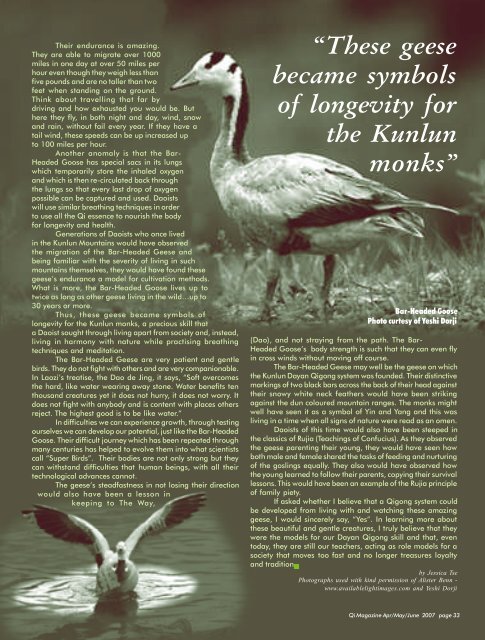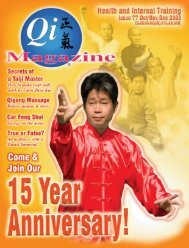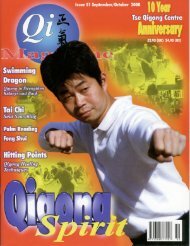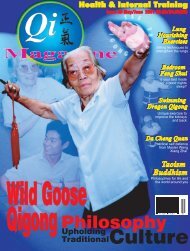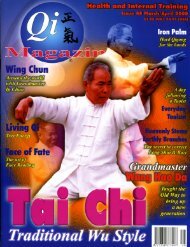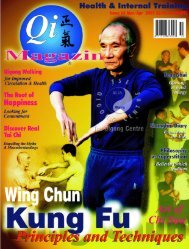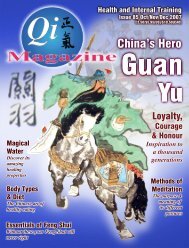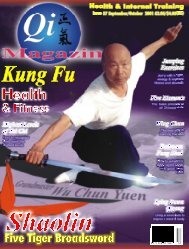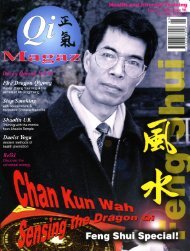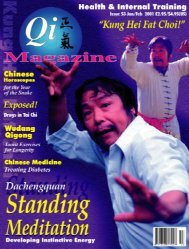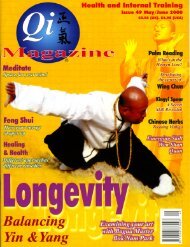You also want an ePaper? Increase the reach of your titles
YUMPU automatically turns print PDFs into web optimized ePapers that Google loves.
Their endurance is amazing.<br />
They are able to migrate over 1000<br />
miles in one day at over 50 miles per<br />
hour even though they weigh less than<br />
five pounds and are no taller than two<br />
feet when standing on the ground.<br />
Think about travelling that far by<br />
driving and how exhausted you would be. But<br />
here they fly, in both night and day, wind, snow<br />
and rain, without fail every year. If they have a<br />
tail wind, these speeds can be up increased up<br />
to 100 miles per hour.<br />
Another anomaly is that the Bar-<br />
Headed Goose has special sacs in its lungs<br />
which temporarily store the inhaled oxygen<br />
and which is then re-circulated back through<br />
the lungs so that every last drop of oxygen<br />
possible can be captured and used. Daoists<br />
will use similar breathing techniques in order<br />
to use all the Qi essence to nourish the body<br />
for longevity and health.<br />
Generations of Daoists who once lived<br />
in the Kunlun Mountains would have observed<br />
the migration of the Bar-Headed Geese and<br />
being familiar with the severity of living in such<br />
mountains themselves, they would have found these<br />
geese’s endurance a model for cultivation methods.<br />
What is more, the Bar-Headed Goose lives up to<br />
twice as long as other geese living in the wild…up to<br />
30 years or more.<br />
Thus, these geese became symbols of<br />
longevity for the Kunlun monks, a precious skill that<br />
a Daoist sought through living apart from society and, instead,<br />
living in harmony with nature while practising breathing<br />
techniques and meditation.<br />
The Bar-Headed Geese are very patient and gentle<br />
birds. They do not fight with others and are very companionable.<br />
In Laozi’s treatise, the Dao de Jing, it says, “Soft overcomes<br />
the hard, like water wearing away stone. Water benefits ten<br />
thousand creatures yet it does not hurry, it does not worry. It<br />
does not fight with anybody and is content with places others<br />
reject. The highest good is to be like water.”<br />
In difficulties we can experience growth, through testing<br />
ourselves we can develop our potential, just like the Bar-Headed<br />
Goose. Their difficult journey which has been repeated through<br />
many centuries has helped to evolve them into what scientists<br />
call “Super Birds”. Their bodies are not only strong but they<br />
can withstand difficulties that human beings, with all their<br />
technological advances cannot.<br />
The geese’s steadfastness in not losing their direction<br />
would also have been a lesson in<br />
keeping to The Way,<br />
“These geese<br />
became symbols<br />
of longevity for<br />
the Kunlun<br />
monks”<br />
Bar-Headed Goose<br />
Photo curtesy of Yeshi Dorji<br />
(Dao), and not straying from the path. The Bar-<br />
Headed Goose’s body strength is such that they can even fly<br />
in cross winds without moving off course.<br />
The Bar-Headed Geese may well be the geese on which<br />
the Kunlun Dayan <strong>Qigong</strong> system was founded. Their distinctive<br />
markings of two black bars across the back of their head against<br />
their snowy white neck feathers would have been striking<br />
against the dun coloured mountain ranges. The monks might<br />
well have seen it as a symbol of Yin and Yang and this was<br />
living in a time when all signs of nature were read as an omen.<br />
Daoists of this time would also have been steeped in<br />
the classics of Rujia (Teachings of Confucius). As they observed<br />
the geese parenting their young, they would have seen how<br />
both male and female shared the tasks of feeding and nurturing<br />
of the goslings equally. They also would have observed how<br />
the young learned to follow their parents, copying their survival<br />
lessons. This would have been an example of the Rujia principle<br />
of family piety.<br />
If asked whether I believe that a <strong>Qigong</strong> system could<br />
be developed from living with and watching these amazing<br />
geese, I would sincerely say, “Yes”. In learning more about<br />
these beautiful and gentle creatures, I truly believe that they<br />
were the models for our Dayan <strong>Qigong</strong> skill and that, even<br />
today, they are still our teachers, acting as role models for a<br />
society that moves too fast and no longer treasures loyalty<br />
and tradition<br />
by Jessica <strong>Tse</strong><br />
Photographs used with kind permission of Alister Benn -<br />
www.availablelightimages.com and Yeshi Dorji<br />
Qi Magazine Apr/May/June 2007 page 33


